August 28, 2023
Field Trip: Japan and Korea
UW Librarians share their journey of discovery to acquire new, historic materials for East Asia studies.
Hyokyoung Yi, Interim Director of Tateuchi East Asia Library and Korea Studies Librarian
Azusa Tanaka, Japan Studies Librarian
Through the advancement of technology and the historically close relationship among East Asia countries, academic research within the field of East Asian Studies is becoming more and more interdisciplinary. UW research within East Asia studies includes comparative literature, migration/mobility and political and economic relationships, to name a few. As subject librarians for Korean and Japanese studies, we seek to support this growing interdisciplinary nature of research by learning about new topics and expanding our library collections to support teaching, learning and research across disciplines.
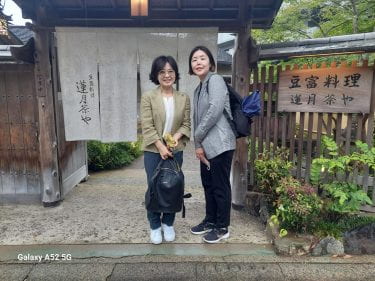
Hyokyoung and Azsusa in Kyoto, Japan
One of the most exciting aspects of our work is the opportunity to travel for acquisition and research on behalf of our subject areas. These acquisition (purchasing) trips take place approximately every other year and are typically planned around a particular theme. Over the summer, we were thrilled to embark on a joint acquisition trip to Korea and Japan. While each of us has made these types of trips many times individually, this is the first acquisition trip that we took together. The theme of our trip this year was the study of Korea-Japan relationships and collections that explore this dynamic. When developing collections that cover politics and other sensitive topics, it becomes even more important to do this work together, side-by-side with equity, diversity and inclusion in mind to ensure our collections support scholarship and research from all perspectives.
We made connections with international colleagues that will benefit our UW community for years to come.
We had an incredible trip, visiting museums, research institutions and neighborhoods where the historical materials of Korean immigrants and their descendants in Japan can be acquired and researched. Traveling together was such a helpful advantage – to be able to rely on each other as communicators and interpreters helped us to deeply understand the experiences and stories of those we met, and the context of the materials we sought out. We made connections with international colleagues that will benefit our UW community for years to come.
We are excited to share what we found and learned on our 2023 acquisition trip to Japan and Korea! While we don’t have the space in this blog to provide a complete account, we are sharing a few of our favorite experiences and “finds” that we hope you will enjoy!
Korea Highlights
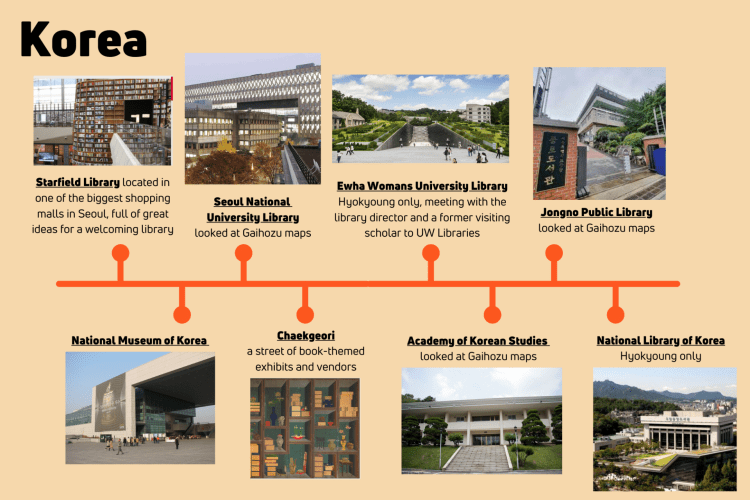
Gaihozu = 外邦図 – Seoul National University
Azusa Tanaka (Japan Studies Librarian): UW Libraries owns a large collection of Japanese Military maps (Gaihozu = 外邦図) which were produced by the former Japanese military, from the 1880s until the end of World War II (1945), and covering the areas of the former Japanese imperial territories (Gaiho = 外邦). I have been researching the provenance of our Gaihozu collection and ways to collaborate with other holding institutions to enhance the accessibility of the collection. The Korean peninsula was thoroughly surveyed to create these maps, many of which are kept at several institutions in Korea, and I was very interested to see how their maps are organized and accessed.
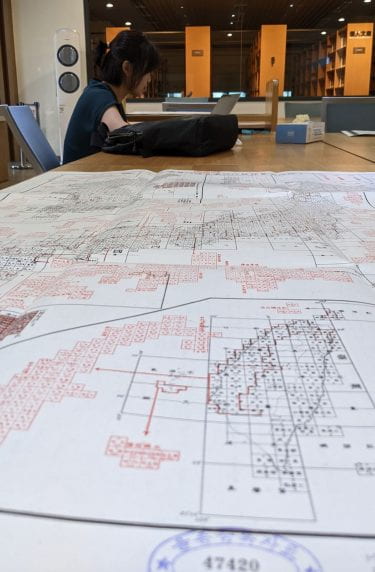
Hyokyoung studies the maps at Seoul National University
One of the highlights of the Korea trip for me was the opportunity to see the Gaihozu maps at Seoul National University. The moment I touched the maps, I noticed the quality of paper is different from our UW Libraries collection of Gaihozu maps which were printed in Japan. The following week, in Tokyo, I shared this with a paper specialist. She explained to me that the Japanese military used the paper which was made locally in Korea, so it is natural that the texture is different from the ones printed in Japan because each region would use the local ingredients and paper making methods. This was an interesting fact that I can share with UW visitors and researchers who use these maps.
Through our travels, we were able to see more than 460 maps in this particular collection…
Hyokyoung Yi (Korea Studies Librarian): I was well aware of our Gaihozu map collection via Azusa’s research and collection development, but through this trip, I gained a new understanding of their connection with Korean history and geography that will benefit my research and knowledge about maps produced in the colonial period of Korea. Through our travels, we were able to see more than 460 maps in this particular collection, all published by the Japanese colonial government preparing for colonization of the area. The maps were drawn carefully in great detail at the level of almost every city and village in the entire Korean peninsula.
We learned unique features of map-specific metadata descriptions, representation of scanned maps and search and retrieval functions which we can apply to our own digitization process or potential collaboration…
While the collection was impressive as a topographic map itself, many holding libraries and institutions we visited in Korea have either finished digitizing or are near completion of digitization. We learned unique features of map-specific metadata descriptions, representation of scanned maps and search and retrieval functions which we can apply to our own digitization process or potential collaboration with them in the future. Identifying Korean holdings of these maps at various locations and their digital accessibility will be useful for me to guide students and scholars who will be looking for maps in this time period of Korea.
National Museum of Korea
Azusa Tanaka (Japan Studies Librarian): When I saw the exhibit of a movable metal type set at the National Museum of Korea, I was inspired with a new perspective on one of the most special items in UW Libraries Japanese collection — a copy of the movable type publication Koetsu utai bon Tadanori (光悦謡本 忠度), a no play vocal book (a classical form of theater originating in the 14th century).
the number of publications printed with this method is quite limited and challenging to find in the market…
The movable type printing technique was introduced to Japan in the late 16th century via the influence of western culture and Christianity, and also by Korea. In pre-modern Japan, the movable type was used only less than 100 years (between late 16th century and mid 17th century), so the number of publications printed with this method is quite limited and challenging to find in the market. It was quite a special moment that I was able to connect this special piece at UW and the Korean piece displayed at the museum. I look forward to sharing this experience and the knowledge I gained from the museum with our UW community and visitors.
Rare Finds
At several of the institutions we visited, we purchased some publications about the history of Korean residents. These unique materials, published exclusively by these institutions, are not available in the general book market, underscoring why these “field trip” visits are so valuable.
Japan Highlights
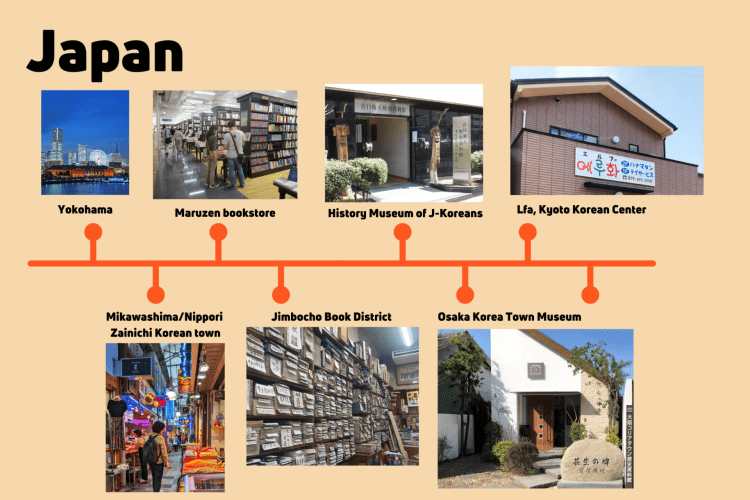
Hyokyoung Yi (Korea Studies Librarian): As librarians, having an in-depth understanding of emerging areas of study is essential to developing well-rounded collections. Within both Korean society and academia, there has been an increased interest in learning more about the history of Korean migrants in Japan, including the history of discrimination as well as Korean migrant’s contributions to Japanese business, education and culture. This trip helped me to explore this topic in greater context and introduced valuable partners that will help expand our collection around these themes.
Jinbocho, and the book town tour with Prof. Sasaki
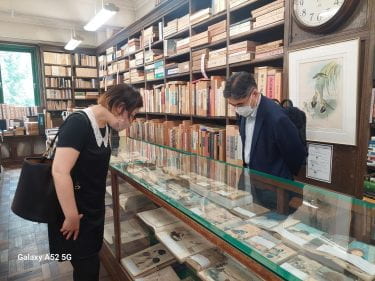
Azusa and Professor Sasaki in Jimbocho bookstore
I was as able to join a special tour of Jinbocho, the Japanese book town, guided by Prof. Takahiro Sasaki (the immediate former Director of the Keio Institute of Oriental Classics (Shido Bunko) at Keio University in Tokyo, Japan). He visited UW in October last year (2022), as part of the exchange program between the University of Washington and Keio University funded by a generous grant from the Tateuchi Foundation.
Each bookstore was crammed floor to ceiling with all kinds of books including rare and special materials…

bookstore in Jinbocho
Jinbocho is the popular area for bibliophiles and book lovers as the town is filled with around 200 book stores within walking distance. Each bookstore was crammed floor to ceiling with all kinds of books including rare and special materials. It was fun to visit store after store where Prof. Sasaki introduced us to a myriad of pre-modern books. The full-day tour in Jinbocho provided an opportunity to explore older Japanese publications and book cultures, which East Asian and Korean materials share a lot in common. At the end of the tour, we found the one and only Korean bookstore in Jinbocho which sells mostly Korean diaspora materials published by Korean-Japanese authors, which were of particular interest for this trip. We came back with a purchase list full of interesting titles both in Korean and Japanese.
Osaka Korea Town Museum
Thanks to Azusa’s help, I was able to visit the brand new Osaka Korea Town Museum, located in the heart of Osaka’s Korea town. While the earliest Korean migrants go back to Paekche period (old Korea 18 BC-660 AD), the major influx of Korean came to this town during the colonial period (1910-1945). The town is a concentrated cultural and historical exchange space between the Korean peninsula and Japan. More recently, the town became popular due to Korean K-pop/drama/film culture’s positive influence in Japan. The museum has a wonderful exhibit and collection devoted to the history of Koreans in Osaka since the early 20th century, including the history of Zainichi Koreans’ life in Japan.
Learning About the Zanichi
| Zainichi (“residents in Japan”) is the term specifically used for ethnic Korean permanent residents of Japan whose migration was originally before 1945 (and their descendants) during Japan’s colonial occupation in the Korean peninsula. Because of such history, these Zainichi are often discriminated against and not given the same level of social benefits even though they were born and raised in Japan just like any other Japanese. They formed their own communities and towns to be together, but some were determined to leave with a desire to more fully assimilate into Japanese society and the broader community. While the Zainichi Korean towns seem to have been hidden or avoided by mainstream tourism in the past, they are gaining more attention in recent years thanks to the K-pop culture boom whereas more Japanese people are interested in visiting the Zainichi Korean towns to appreciate and learn about their culture. |

commemorative book of the Ikaino Korean School
Understanding the collection scale and the availability will guide my direction for immediate collection development with practical information like publishers and creators to follow up with…
My visits to various historical museums and neighborhoods of Zainichi Koreans in Japan help me understand what types of resources were published locally and collected by those museums’ libraries or special bookstores. For example, I was able to identify many local publications and archives in Japan including local newspapers, literary magazines, dissertations, historical archives and reference books of biography, etc. on this specific topic. Some were written in Korean while others were published in Japanese, so the coordination between me and Azusa will be essential to continue building the collection in this specific area. These marginalized resources in Japan are difficult to discover due to the nature of the minority publications, the language barrier and lack of online publication information. Understanding the collection scale and the availability will guide my direction for immediate collection development with practical information like publishers and creators to follow up with.
We were lucky to meet a staff member and a museum board member who shared their personal stories of life living as Korean descendents in Japan fighting against discrimination and identity issues. We secured a copy of a commemorative book of the Ikaino Korean School in Osaka which was closed early this year after seventy-six years serving Korean students.
More Rare Finds
Another amazing artifact coming back to UW with us is a set of annual Ise Jingu Shrine calendar publications from the 17th century, Ise goyomi (伊勢暦). Asuza purchased this at Jnbocho, adding to the UW Libraries collection that includes another long run annual publication from the similar time period (17th century) Japan, Bukan (武鑑), Daimyo registry. These two are a good comparison when you study the time period—whether it is about the culture, politics, climate, or book-making history. Our collections (curated with Asuza’s expertise) include all kinds of different book binding formats, styles and papers that provide excellent primary sources for a variety of teaching and research needs. Using these two sets of annual publications that ran more than a hundred years, scholars might be able to discover how bookmaking methods change over time from one period to the other.
Acquisition trips like this are crucial to support teaching and research at a global scale.
Lasting Connections
We are grateful for this travel opportunity. Acquisition trips like this help build our collections, but also offer professional development for the area studies specialists to keep up with real time trends in the market and in localized business, culture and academia that are hard to grasp remotely, but crucial to support teaching and research at a global scale.
The joint trip gave us a better mutual understanding on what’s existing in the publishing markets of Japan and Korea, while creating many new connections with people and partners who will enhance project collaboration and knowledge exchanges. These connections and partnerships help us to better assist our students and faculty with richer reference services, whether they are physical materials or human resources. As librarians, we can often act as a gateway to resources beyond geographical boundaries and the physical spaces of our libraries. These acquisition trips are invaluable for us to connect people with knowledge wherever and whenever opportunities arise and become available.
To learn more about these collections and to connect directly with Azusa or Hyokyoung:
- Korea Studies LibGuides – contact Hyokyoung Yi
- Japan Studies LibGuides – contact Azusa Tanaka
###
